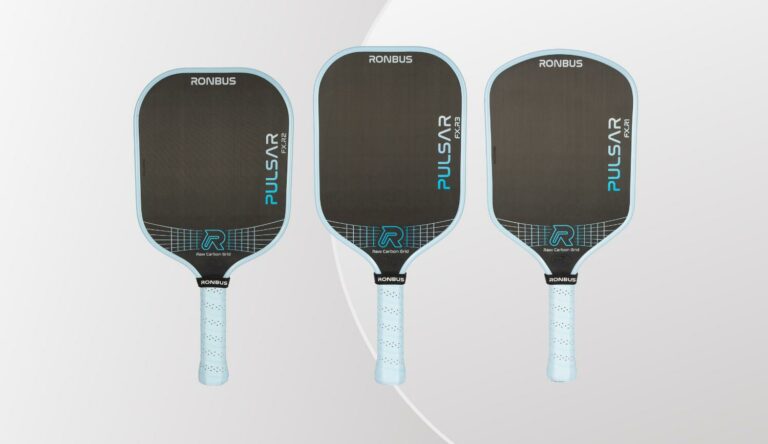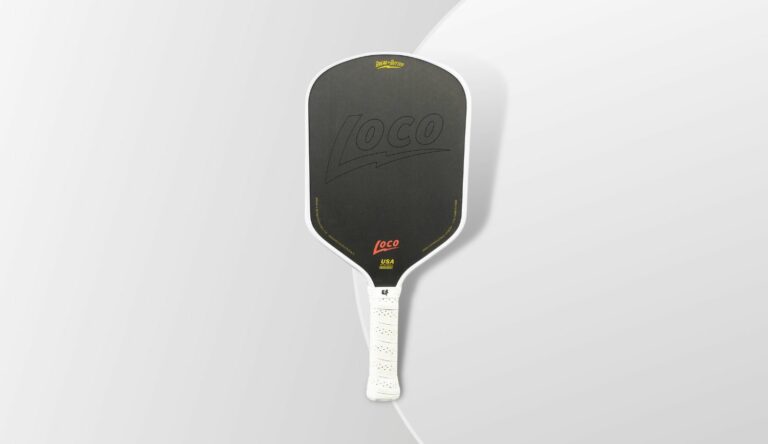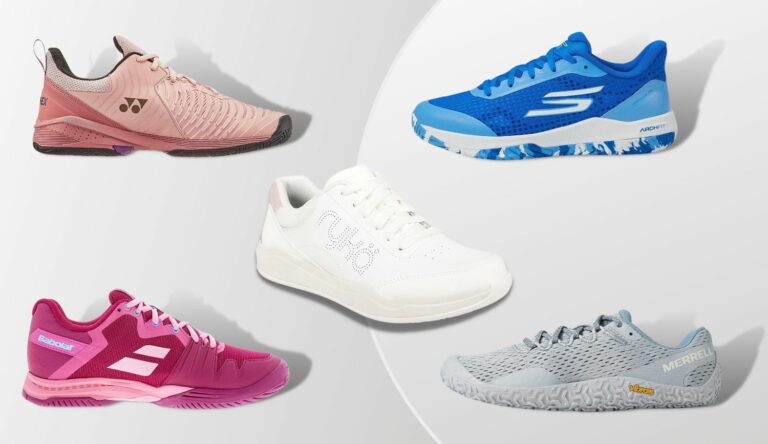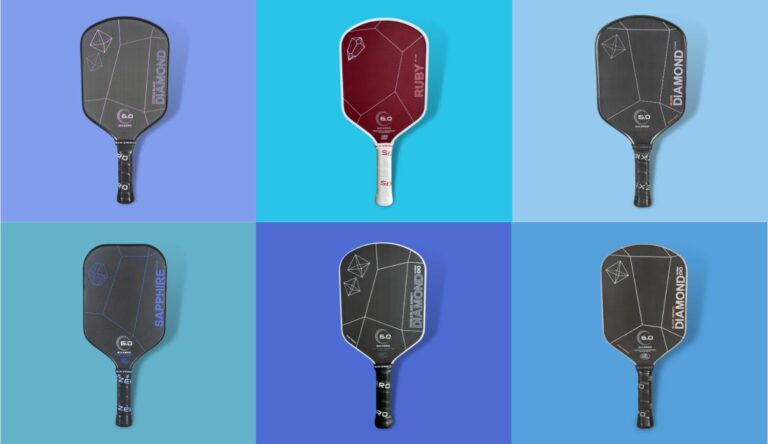In 2022, the pickleball paddle industry was dominated by a few major companies. The Joola Hyperion line was considered one of the top paddles of the year.
In 2023, Ronbus is pushing innovation by making a paddle that plays incredibly similar to the Hyperion CFS while only costing half as much.
I’m excited to review this one today. I’ve received a lot of questions about the Ronbus from people whom I’ve lent mine out to or who’ve seen me play with it.
Let’s dive into the review.
Contents
Ronbus R1.16 Technical Specifications
- Price:
$120($100 with code DASHPB) - Type: All-court/control
- Warranty: 6-month warranty
- Shape: Elongated
- Core thickness: 16mm
- Face: Raw Toray T700 Carbon Fiber
- Average weight: 8.2 oz
- Grip length: 5.5″
- Swing Weight: 117
- Grip size: 4.25″
- Core: Polypropylene Honeycomb
- Total length: 16.5″
- Width: 7.5″
Quick Summary
The Ronbus R1 is a clean-looking paddle that checks off all of the boxes for an all-court paddle.
It does an excellent job as a hybrid paddle offering control, speed, spin, and power. The spin and control from this paddle are top-tier, while the power provided is more than adequate for most people.
Note that the Ronbus R3.16 paddle is essentially the same as the R1.16 paddle except for subtle shape differences. The R1 shape is similar to the rounded top SixZero Black Diamond and Vatic Pro Flash paddles, while the R3 is more square at the top. The R3 shape looks similar to Ronbus R3 Pulsar, Legacy Pro, Vatic Pro V7/V7 Prism, and Joola Perseus.
R1 Pros:
- Plays very similarly to the Joola Hyperion CFS for cheaper. The Ronbus shares a ton of characteristics with the Hyperion. Plush feel, power when you need it, a wide sweet spot, and a solid build quality (no exposed polymer).
- Great control. The Ronbus is forgiving with a good sweet spot. It’s great for players who want more touch. It has a soft feel for drops, resets, and dinks.
- Balanced. The Ronbus has a good balanced and feels right in my hands. It’s not too heavy and not too light. Overall, I don’t think it’s head heavy, but I had one person who borrowed mine say that they thought it was, although much less so than the Hyperion.
- Quick. The Ronbus plays light with a low swing weight. It moves quickly and gives you fast hands at the net/kitchen. I’ve found that it feels and moves lighter than the Hyperion. Being less head-heavy helps that.
- Long handle length. This could be a negative for some people. But I find the 5.5″ handle to be a perfect length, especially for people who like to use a two-handed backhand in their game.
- Appealing aesthetics. This is of course subjective, but I find the less-is-more minimalist design of the Ronbus R1 to be appealing. The understated looks is very clean.
R1 Cons:
- No edge foam. While the R1 has a pretty wide and forgiving sweet spot, it does not feature the edge foam injection that the Hyperion does. Edge foam would give it slightly more control and a bigger, more forgiving sweet spot. If you want edge foam in a similarly priced paddle, then the Vatic Prism paddles are your best bet.
Power Summary
It won’t hit as hard as the new unibody thermoformed paddles, but you still get plenty of putaway power with the R1. If you can generate your own power and pace, you should find it easy to finish points with pace and power.
You also don’t control with the R1 like you would with a dedicated power paddle or thermoformed paddle. The Ronbus has more power than the Halo or Warrior Edge while being very soft and controllable. It’s a great balance for non-power players or newer players that would otherwise struggle not to sail every ball out with a true power paddle.
If you want more power from the Ronbus R1, use lead tape. Just a little bit will give you an extra powerful punch to put away drives fast and hard.
Control Summary
The Ronbus is a great control paddle. It’s soft and plush with a good sweet spot, making it a third-shot drop machine.
The 16mm core makes dinking and resets very enjoyable. It’s an excellent paddle to give you confidence in your soft game, especially at the kitchen line, where you can dial in your dinks and cat-and-mouse game.
I love the newer thermoformed paddles like the Legacy Pro, Vatic Pro, and SixZero Black Diamond. But they’re harder to control, and sometimes I just want easeful dinking and resets, so I’ll swap over to my Ronbus R1.
Spin Summary
The Ronbus paddle has very high spin. Whatever they’re doing, it’s working. Chris Olsen at Pickleball Studio’s tests with the R1 resulted in RPMs over 2100, which made it an easy choice to add the R1.16 to my list of the best paddles for spin. The high spin rate from the R1 is definitely unbeatable at this price point.
The high spin rate could be attributed to the Toray T700 carbon fiber surface the Ronbus is using. It’s top high quality and creates some serious grit and grip on the ball. You can place the ball where you want it with minimal spin mechanics. The paddle does a lot of the work for you.
Durability Summary
The Ronbus is new enough that I don’t have extensive durability results yet. But it feels well made and there’s no flimsy construction.
Looking at the grip, there’s no exposed polymer underneath the overgrip, which is a good sign. A lot of paddle companies at this price range cheap out and dont seal in the honeycomb cores. The edge guard seems well glued, which is important, as the edge guard is a common durability weak point on some paddles.
The paddle also looks well-supported at the throat. The Hyperion paddles have had a lot of breakage issues here. Side by side with my Hyperion, the Ronbus looks more stable here.
Value Summary
This paddle offers one of the best values in the pickleball market right now. You get great spin, and control, with a good amount of power around a $100 price point. This is a legitimate contender to the Joola Hyperion, which retails at $220. The Ronbus is absolutely better in my opinion than the Joola Vision line, which costs $170.
The Volaire Mach 1 paddle, which is Julian Arnold’s signature pro line model, is identical to the Ronbus R1. They’re sourced from the same factory with literally the same design (same grip, shape, head, and feel). And that paddle is $160.
Should you buy a Ronbus R1.16 or R3.16 paddle?
The Ronbus R1.16 and R3.16 paddles are my go-to recommendation for a Joola Hyperion-like paddle that’s less than half the price of the Joola. Any beginner or intermediate player who loves a high-quality all-court control paddle should pick this one up. It’s topped my best intermediate player paddle list.
This paddle is well-rounded and well-built. I’ve had no problem spinning the ball, hitting powerful deep serves, or dinking with great touch.
I’ve actually moved away from my Hyperion CFS 16mm and Vision 16mm to the Ronbus, which took me by surprise. Dong, the CEO of Ronbus, definitely knows what he’s doing when creating a paddle.
The R1.16 and R3.16 paddles are priced at ($100 using code DASHPB) at the Ronbus website, I’d still recommend this paddle if it was closer to $150. It easily topped my best paddles under $100 list.
If you think you want more power than the Ronbus can offer, I recommend any of the new unibody thermoformed raw carbon fiber paddles that recently hit the market. The thermoformed Ronbus Pulsar, Legacy Pro, Vatic Pro, and SixZero Black Diamond Power / Double Black Diamond Control paddles are all phenomenal and are offered at a great price. You can use the code DASHPB for 10% off for any of those paddles.







3 thoughts on “Ronbus R1.16 Pickleball Paddle Review (Power, Spin, Control)”
Sir you mentioned you recommended the use of lead tape for more power.
My question is how much lead tape ? And where should I put the lead tape ?
Thank you. Keep up the great work.
Please make a review of the Vatic Pro Flash 16mm and the Legacy Pro S 16mm.
Thanks.
I have a Ronbus R2.16 and like the control and spin. The ball seems to transfer material to paddle allowing you to see where you are hitting the ball. I occasionally rub my fingers with the grain (runs parallel to handle) to remove ball transfer.
R2.16 is an underrated shape. Word is the newer R2 shaped models will be more similar to the Joola Scorpeus shape. Good idea on removing ball dust.